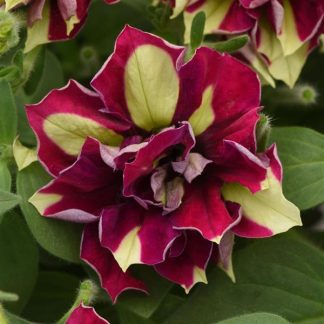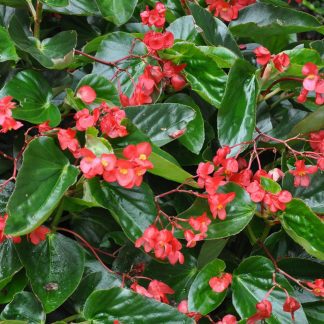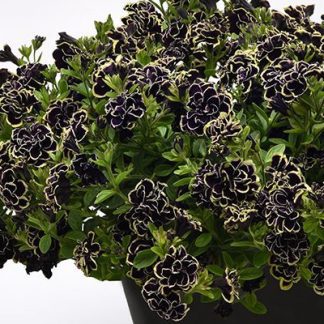Description
Petunia ‘Headliner Night Sky’: A Galaxy Blooming in Your Garden
Welcome to the Night Sky
Have you ever looked up on a clear summer night and felt awed by the endless spread of stars? Petunia ‘Headliner Night Sky’ gives you that same wonder, right at eye level. Each violet-blue petal is speckled with creamy white, creating little constellations that shift with light and temperature. When we bring this plant home, we invite the cosmos to spill over hanging baskets, window boxes, and sunny beds. Let’s dive into its story, its look, and, most of all, the simple steps that help it thrive.
A Living Star Map
Where This Variety Began
Plant breeders in Germany first noticed a single petunia that bloomed with irregular, star-like spots. Instead of dismissing it as an oddity, they nurtured the trait. After more than a few seasons of careful selection, the Headliner series was born. Night Sky remains the flagship. It won Europe’s prestigious FleuroStar Award in 2015 and has wowed gardeners worldwide ever since.
What Makes Night Sky Special
- Dynamic Coloring. Spots change with temperature. Cooler nights deepen the purple and enlarge the speckles. Warmer days soften the hue and scatter tiny dots.
- Mounded–Trailing Habit. Plants billow 10–16 inches high and trail 18–24 inches, filling baskets with ease.
- Continuous Blooming. From late spring until frost, new blossoms replace the old without pause. We get months of color for minimal effort.
- Pollinator Friendly. Bees and butterflies cannot resist the sweet scent and landing pad petals.
Up-Close Description
Flower Form and Color
Look closely. Each five-lobed bloom opens about 3 inches wide. The base color is rich royal purple—sometimes leaning to navy, sometimes closer to plum. Speckles range from tiny dots to broad splashes. In other words, no two flowers are the same. That living pattern turns every glance into a fresh experience.
Foliage and Stems
Leaves are soft, medium green, and slightly sticky—a typical petunia trait that helps trap pests. Stems are flexible yet sturdy, allowing gentle drape without snapping. When planted near edges, they spill over like a scenic waterfall.
Growth Rhythm
Night Sky grows fast. Seedlings reach transplant size in 6–8 weeks, and buds appear soon after. Once roots anchor, daily sun fuels an endless cycle of new buds, opening flowers, and gentle fading. We wake each morning to a renewed sky.
Caring for Petunia ‘Headliner Night Sky’
Light: Full Sun Is Key
Give at least six hours of direct sun. But most of all, aim for eight to ten hours for the boldest purple and the most speckles. In part shade, plants survive yet bloom sparsely and may stretch.
Soil: Loose, Rich, Well-Drained
- Texture. Light, fluffy mixes help roots breathe.
- Fertility. Night Sky is a hungry star. Blend compost or a slow-release, balanced fertilizer (such as 14-14-14) into planting holes.
- pH. Aim between 6.0 and 6.5. Slightly acidic soil aids nutrient uptake.
Water: Steady, Even Moisture
Keep soil consistently moist, instead of letting it swing between soggy and bone-dry. A good rule: Water when the top inch feels dry. In hanging baskets, daily watering may be needed during hot spells. Try a soil-moisture meter if you struggle to gauge by touch.
Feeding: Fuel for Endless Stars
Petunias reward regular feeding. Use liquid fertilizer (20-10-20 or similar) every one to two weeks. For organic gardens, fish emulsion and seaweed blends work well. After more than a month of growth, watch lower leaves; pale color hints at nitrogen hunger.
Temperature: Cool Nights Bring Drama
Night Sky’s speckles expand in night temperatures between 50 °F and 65 °F (10–18 °C). Warmer nights shrink the spots, amplifying purple. Either way, the show goes on. Protect from frost, since tender tissues blacken below 32 °F (0 °C).
Pruning and Deadheading
While the plant self-cleans fairly well, pinching off the longest shoots midway through summer keeps baskets full and bushy. Shear lightly by one-third if blooming slows. Fresh growth appears within a week, and flowers follow swiftly.
Pests and Problems
- Aphids and Whiteflies. Blast with water, then apply insecticidal soap.
- Botrytis (gray mold). Avoid overhead watering; space plants for airflow.
- Iron Chlorosis. Yellow leaves with green veins? Waterlogged soil or high pH may lock out iron. Improve drainage and add chelated iron if needed.
Overwintering Tips
Petunias are annuals in most regions. Yet we can overwinter cuttings indoors under bright grow lights. Snip 3-inch tips in early fall, root them in damp perlite, and keep temperatures near 70 °F (21 °C). By spring, vigorous young plants stand ready for the garden.
Design Ideas and Companions
Containers That Wow
- Cosmic Cascade Basket. Combine Night Sky with silver dichondra for a star-and-moon effect.
- Patio Nebula Pot. Pair with lime green sweet potato vine. Vivid contrast magnifies each spot.
- Rocket Launch Window Box. Mix red calibrachoa and white alyssum for a patriotic galaxy.
In-Ground Magic
Border edges shine when Night Sky spills over retaining walls. Use it in a moon garden alongside white gaura and dusty miller. In butterfly beds, set against orange lantana to guide pollinators.
Companion Planting Wisdom
Choose neighbors that share sunlight and water preferences. Avoid tall, sprawling plants that might shade petunias. Herbs like thyme and oregano repel some pests while adding fragrance. Marigolds, well-known for nematode control, also provide warm color accents.
Propagation and Seed Saving
Cutting Method
- Select non-flowering shoots 3–4 inches long.
- Remove lower leaves.
- Dip in rooting hormone powder.
- Insert into moist, sterile medium.
- Cover with a clear dome or plastic bag to hold humidity.
Roots appear in 7–10 days. Harden off by gradually lifting the cover.
Seed Reality
Night Sky seeds do not breed true; seedlings rarely show the same speckles. For that reason, professional growers rely on cuttings or tissue culture. If you enjoy surprises, sow saved seed—it can be fun to see what patterns emerge.
Troubleshooting Quick Guide
| Symptom | Likely Cause | Simple Fix |
|---|---|---|
| Faded Purple | Insufficient light | Move to sunnier spot |
| Few Speckles | Very warm nights | Provide afternoon shade or wait for cooler season |
| Leggy Growth | Too little sun / no pruning | Pinch stems; give more light |
| Sticky Leaves + Ants | Aphids | Wash off; apply soap spray |
Frequently Asked Questions
Q: Why did my Night Sky turn almost solid purple?
A: Temperature drives the speckles. Nights above 70 °F (21 °C) reduce spotting. Cooler weather will restore the pattern.
Q: Can I grow it from seed?
A: Yes, yet seedlings seldom copy the parent’s pattern. If you want identical blooms, buy young plants or root cuttings.
Q: Is it deer resistant?
A: Deer may browse petunias when food is scarce. Use fencing, repellents, or plant in elevated containers if deer are common.
Q: How do I keep blooms coming all summer?
A: Feed regularly, water evenly, and shear lightly in mid-season to prompt new growth.
Bringing the Night Sky Home
We garden for many reasons—beauty, food, calm moments under the sun. Petunia ‘Headliner Night Sky’ reminds us that wonder can live in small spaces. We don’t need a telescope. We only need a pot, a patch of good soil, and a bit of care. When you step outside at dusk and see those speckled petals still glowing, you’ll feel connected to something vast and timeless.




